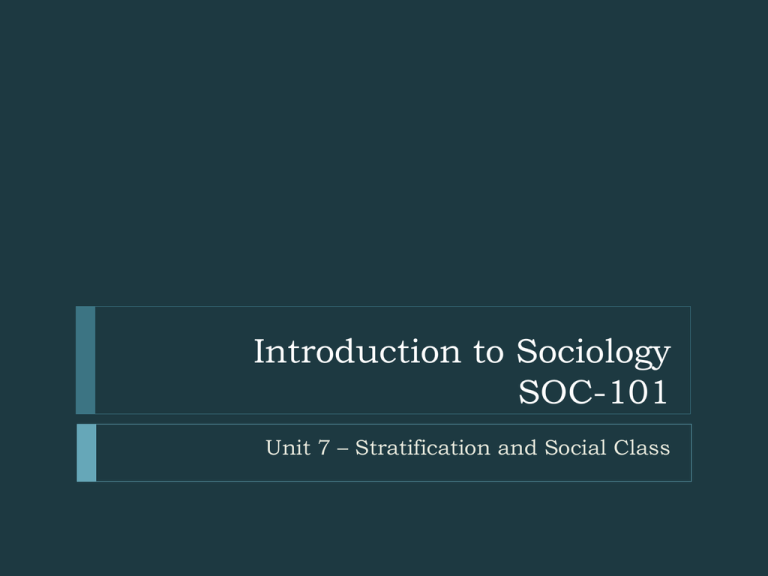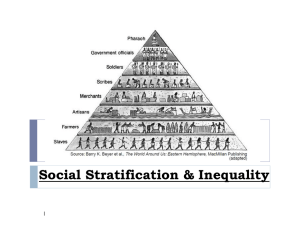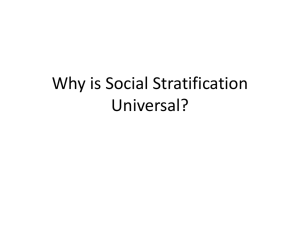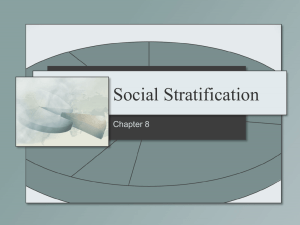
Introduction to Sociology
SOC-101
Unit 7 – Stratification and Social Class
Systems of Social Stratification
Social stratification
A system in which people are divided into layers according to
their relative power, property, and prestige
Refers to the ranking of large groups of people rather than
individual people
Every society stratifies its members
The degree of inequality varies
No matter what system a society may use to divide people
into different layers, gender is always an essential part of the
distinctions within each layer
On the basis of gender, people are sorted into categories and given
differential access to rewards
Social distinctions have usually favored males
Systems of Social Stratification
Slavery
Form of social stratification in which some people own other
people
Initially slavery was based on debt, punishment for violation of
the law, or defeat in battle
Many of the first slaves were women, captured after the defeat of
their village
Slavery could be temporary or permanent and was not
necessarily passed on to one’s children
Typically, slaves owned no property and had no power
This was not universally true, however
Systems of Social Stratification
Slavery (con’t)
American colonists first tried to enslave Indians
Then turned to Africans, who were being brought to North and South
America by the British, Dutch, English, Portuguese, and Spanish
When American slave owners found it was profitable to own
slaves for life, they developed an ideology around the idea and
to made slaves inheritable
Although illegal, slavery still exists in places like the Sudan and
Mauritania
Villages are raided, the men killed, and the women and children
captured and sold
Systems of Social Stratification
Caste Systems
Status is determined by birth and is lifelong
Ascribed status is the basis of a caste system
Caste societies try to make certain that the boundaries
between castes remain firm
Practicing endogamy (marriage within their own group)
Developing rules about ritual pollution, teaching that contact with
inferior castes contaminates the superior caste
Although abolished by the Indian government in 1949, the
caste system remains part of everyday life in India
Systems of Social Stratification
Caste Systems (con’t)
This system is based on religion and is made up of four main
castes which are subdivided into thousands of specialized
subcastes or jati
The lowest caste is considered to be "untouchable," and ablution
(washing rituals) is required to restore purity for those contaminated
by individuals from this group
An American racial caste system developed in the United
States when slavery ended
Even in the earlier parts of this century, all whites were considered
higher than all African Americans and in the South, separate
accommodations were maintained for each race
Systems of Social Stratification
Class system
Form of social stratification based primarily on the possession
of money or material possessions
An individual’s initial social class position is based on that of
her or his parents (ascribed status)
A class system allows for social mobility—movement up or
down the social class ladder—based on achieved status.
Gender cuts across slavery, caste, and class
In all societies, gender becomes the basis for the distribution of
the good things available in the society
India’s Caste System
What Determines Social Class?
Karl Marx (1818-1883)
Social class is determined by one’s relationship to the means of
production—the tools, factories, land, and investment capital
used to produce wealth
Modern society is composed of just two classes of people
Bourgeoisie (capitalists) own the means of production
Proletariat (workers) work for those who own the means of
production
As capital becomes more concentrated, the two classes
become increasingly more hostile to one another
What Determines Social Class?
Class consciousness develops
Awareness of a common identity based on one’s position in
the means of production
According to Marx, this is the essential basis for the unity of
workers
Marx believed that the workers would revolt against the
capitalists, take control of the means of production, and
usher in a classless society
However, the workers’ unity and revolution are held back by
false class consciousness—the mistaken identification of
workers with the interests of capitalists
What Determines Social Class?
Max Weber (1864-1920)
Did not believe that property was the sole basis of a person’s
position in the stratification system
Rather he believed that it was property, prestige, and power
that determined social class
Property is an essential element
Prestige may be derived from ownership of property
However, some powerful people, like managers of corporations,
control the means of production even though they do not own them
This may also be based on other factors, such as athletic skills
Power is the ability to control others, even over their
objections
Why is Social Stratification Universal?
Kingsley Davis and Wilbert Moore (1945, 1953)
Functionalists who believed social stratification is inevitable
Society must make certain that its important positions are
filled with qualified people and to guarantee this the society
offers them greater rewards
Argued that because society offers greater rewards for its
more responsible, demanding, and accountable positions,
qualified people compete for them
Why is Social Stratification Universal?
Melvin Tumin (1953) criticized the functionalist view
Argued that the importance of a position cannot be measured
by the rewards, and that such an argument is circular
Noted that if stratification worked as Davis and Moore
describe it, society would be a meritocracy
There must be independent indicators of importance
A form of social stratification in which all positions are awarded on
the basis of merit
But it does not work this way (e.g., the best predictor of college
entrance is family income, not ability)
Also argued that money and fringe benefits are not the only
reasons people take jobs
Noted that stratification is dysfunctional, not functional, to
many people
Why is Social Stratification Universal?
Conflict theorists stress that conflict, not function, is the
basis of social stratification
Every society has limited resources to go around and each
group struggles with one another for those resources
Whenever a group gains power, it uses that power to extract
what it can from the groups beneath it.
The dominant group takes control of the social institutions,
using them to keep other groups weak and preserve the best
resources for itself
Why is Social Stratification Universal?
Gaetano Mosca (1896) argued that it is inevitable that
every society will be stratified by power
This is because the ruling class is well organized and enjoys
easy communication among its relatively few members
It is extremely difficult for the majority they govern to resist
Society cannot exist unless it is organized
Political power developed to get the work of society done
Politics results in inequalities of power because some people
take leadership positions and others follow
It is human nature to be self-centered
Thus, people in positions of power use their positions to bring greater
rewards to themselves
Why is Social Stratification Universal?
Marx argued that the bourgeoisie are in power because
they control society’s resources
They are using those resources to benefit themselves and to
oppress those beneath them
Modern conflict theorists stress that conflict between
capitalists and workers is not the only important conflict
in contemporary society
The competition for scarce resources results in conflict not
only between groups from different classes, but also between
groups within the same social class
E.g., young vs. old and women vs. men
Why is Social Stratification Universal?
Gerhard Lenski (1966) offered a synthesis between
functionalist and conflict theories
Functionalists are right when it comes to societies that have
only basic resources and do not accumulate wealth
Includes hunting and gathering societies
Conflict theorists are right when it comes to societies with a
surplus
In such societies humans pursue self-interests and struggle to control
those surpluses
This leads to the emergence of a small elite who then builds inequality
into the society, resulting in a full-blown system of social stratification
How Do Elites Maintain Stratification?
Social stratification is maintained within a nation because
elites control ideas and information, maintain social
networks, and use force
Ideology can be more effective than the use of brute
force in maintaining inequality
The control of ideas is used by elites everywhere to maintain
their positions of power—whether in dictatorships or in
democracies
To the degree that their ideologies are accepted by the masses,
political arrangements are stable
Example: divine right of kings
How Do Elites Maintain Stratification?
Controlling Speech and Information
In a dictatorship, elites use the threat of force to try to control
information
In a democracy, they manipulate the media by the selective
release of information.
Controlling Technology
Technology aids the elite in preserving its position by enabling
them to monitor citizens’ activities without their even being
aware that they are being observed
Comparative Social Stratification
Great Britain’s class system can be divided into upper,
middle, and lower classes
About half of the population is in the lower or working class
Half is in the middle class
About 1 percent is in the upper class
The British are extremely class conscious
Language and speech patterns are important class indicators
Education is the primary way the class system is perpetuated from
one generation to the next
Comparative Social Stratification
In the Soviet Union, the ideal of communism—a classless
society—was never realized.
The major basis for stratification was membership in the
Communist Party
This consisted of top party officials, a relatively small middle class, and
a massive lower class of peasants and unskilled workers
Soviet leaders, frustrated over time with the system’s inability
to be economically successful, initiated capitalistic reforms in
the hopes of turning things around
The transition to capitalism has taken bizarre twists
Some Russians organizing into criminal groups, stealing vast amounts
of state property, amassing great wealth, and intimidating business
people
Global Stratification: Three Worlds
Until recently global stratification was depicted using a
simple model consisting of
First World - industrialized capitalist nations
Second World - Communist nations
Third World - all the rest of the nations
With the collapse of communism, these terms became
outdated, while other models implied moral judgments
about levels of development
A more neutral framework describes degrees of
industrialization and depicts, on a global level, the three
primary dimensions of social stratification: property, power, and
prestige.
Global Stratification: Three Worlds
Most Industrialized Nations
U.S., Canada, Great Britain, France, Germany, Switzerland, and
other industrialized nations of western Europe, as well as Japan,
Australia, and New Zealand
They are capitalistic, although variations exist in their
economic systems and their wealth is enormous
The poor in these countries live better/longer than the average
citizens in the Least Industrialized Nations
Global Stratification: Three Worlds
Industrializing Nations
Include the former Soviet Union and its satellite countries in
Eastern Europe
People living in these countries have considerably lower
income and a poorer standard of living than people in the Most
Industrialized Nations, but better than those living in the Least
Industrialized Nations
Least Industrialized Nations
Where most people live on farms or in villages with low
standards of living
68 percent of the world’s population lives in these nations
Process of Global Stratification
Colonialism occurred when industrialized nations made
colonies of weaker nations and exploited their
labor/natural resources
European nations tended to focus on Africa, while the U.S.
concentrated on Central and South America
The more powerful European nations planted their national
flags in a colony and sent representatives to run the
government
The U.S. planted corporate flags in the particular colony and let
corporations dominate the territory’s government
Process of Global Stratification
Western imperialism and colonialism shaped the Least
Industrialized Nations
Drew lines across a map to divide up their spoils
Created states without regard for tribal or cultural
considerations
The legacy of European conquests still erupts in tribal
violence
Tribes with no history of national identity were arbitrarily
incorporated into the same political boundaries
Process of Global Stratification
World System Theory – Immanual Wallerstein (1974)
Believed that countries are politically and economically tied
together
There are four groups of interconnected nations
Core nations, where capitalism first developed
Semi-periphery nations (Mediterranean area), which are highly
dependent on trade with the core nations
Periphery nations (eastern Europe), those mainly limited to selling
cash crops to the core nations, with limited economic development
External area nations (most of Africa/Asia), which have been left out
of the growth of capitalism and have few economic ties to the core
nations
Process of Global Stratification
World System Theory (con’t)
A capitalist world economy (capitalist dominance) results from
relentless expansion
Even external area nations are drawn into this commercial web
Globalization
The extensive interconnections among nations resulting from the
expansion of capitalism
This has speeded up due to new forms of communication and
transportation
The consequence is that no nation lives in isolation
Process of Global Stratification
Culture of Poverty - John Kenneth Galbraith (1979)
Argued that some nations remain poor because they are
crippled by a culture of poverty
This is a way of life based on traditional values and religious beliefs
that perpetuate poverty from one generation to the next
Keeps some of the Least Industrialized Nations from developing
Most sociologists find colonialism/world system theory
explanations preferable to the culture of poverty theory
This is because the later places the blame on the victim
But each theory only partially explains global stratification
Maintaining Global Stratification
Neocolonialism
The economic and political dominance of the Least
Industrialized Nations by the Most Industrialized Nations
Michael Harrington (1977) asserts that this occurs because the
Most Industrialized Nations control markets, set prices, etc.
They move hazardous industries into the Least Industrialized Nations
and sell weapons and manufactured goods to the Least Industrialized
Nations, preventing them from developing their own industrial
capacity
Modern examples: West control of the Middle East
Maintaining Global Stratification
Multinational corporations contribute to the exploitation
of the Least Industrialized Nations
They exploit these nations directly by controlling national and
local politics, running them as a fiefdom.
Multinational corporations work closely with elites of the Least
Industrialized Nations, funneling investments to this small circle of
power in exchange for its cooperation
The Most Industrialized Nations are the primary beneficiaries
of profits made in the Least Industrialized Nations.
In some situations, multinational corporations may bring
prosperity to the Least Industrialized Nations
New factories provide salaries and opportunities which otherwise
would not exist for workers in those countries
Maintaining Global Stratification
The new technology favors the Most Industrialized
Nations, enabling them to maintain their global
domination.
The profits of multinational corporations can be invested in
developing and acquiring the latest technology, thereby
generating even greater profits
Many of the Least Industrialized Nations do not have the
resources to invest in new technology, which creates an even
greater gap between the levels of industrialization globally
What is Social Class?
Weber defined social class as a large group of people who
rank close to each other in wealth, power, and prestige
Wealth
Consists of property (what we own) and income (money we
receive)
Wealth and income are not always the same—a person may
own much property yet have little income, or vice versa.
Usually, however, wealth and income go together
Ownership of property (real estate, stocks and bonds, etc.) is
not distributed evenly
10% of the U.S. population owns 70 percent of the wealth
The richest 1% of U.S. families are worth more than the entire
bottom 90 percent of Americans
What is Social Class?
Wealth (con’t)
Income is also distributed disproportionately
The changes that have occurred indicate growing inequality
Top 20% of U.S. residents earn 47% of the income
Bottom 20 percent receive less than 5%
Each fifth of the U.S. population receives approximately the same
proportion of national income today as it did in 1945
The richest 20% of U.S. families have grown richer while the poorest
20% percent have grown poorer
Apart from the very rich, the most affluent group in U.S.
society is the executive officers of the largest corporations
Their median compensation is $7.6 million a year
A CEO’s income is 200 times higher than the average pay of U.S.
workers
What is Social Class?
Power
The ability to carry out your will in spite of resistance and is
concentrated in the hands of a few—the “power elite”
Share the same ideologies and values, belong to the same clubs, and
reinforce each other’s world view
No major decision in U.S. government is made without their
approval
What is Social Class?
Prestige
The respect or regard people give to various occupations and
accomplishments
Occupations are the primary source of prestige
2. For prestige to be valuable, people must acknowledge it
Those with the highest prestige pay more, require more education,
entail more abstract thought, and offer greater autonomy
Occupational prestige rankings tend to be consistent across countries
and over time
The elite traditionally create rules to emphasize their higher status
Status symbols, which vary according to social class, are ways
of displaying prestige
In the U.S., they include designer label clothing, expensive cars,
prestigious addresses, and attendance at particular schools
What is Social Class?
Status inconsistency
The situation of people who have a mixture of high and low
rankings in the three components of social class (wealth,
power, and prestige)
Most people are status consistent—they rank at the same level
in all three components
People who are status inconsistent want others to treat them on the
basis of their highest status, but tend to be judged on the basis of
their lowest status
Sociologist Gerhard Lenski determined that people suffering
the frustrations of status inconsistency are more likely to be
radical and approve political action aimed against higher status
groups
Sociological Models of Social Class
The number of classes that exist in an industrial society is
a matter of debate
There are two main models: one that builds on the ideas
of Marx and the other on those of Weber
Sociological Models of Social Class
Erik Wright (1985)
Realized that not everyone falls into Marx’s two broad classes
(capitalists and workers)
For instance, although executives, managers, and supervisors fall into
Marx’s category of workers, they act more like capitalists
Wright resolved this problem by regarding some people as
simultaneously members of more than one class, occupying
what he called contradictory class locations
Wright identified four classes:
Capitalists, the owners of large enterprises
Petty bourgeoisie, the owners of small businesses
Managers, the employees with authority over others
Workers, who sell their labor to others
Sociological Models of Social Class
Dennis Gilbert and Joseph Kahl (1998, 2008) created a
model to describe class structure in the United States
and other capitalist countries
The capitalist class (1 percent of the population) is composed
of investors, heirs, and a few executives
It is divided into “old” money and “new” money
The children of “new” money move into the old money class by
attending the right schools and marrying “old” money
The upper middle class (15 percent of the population) is
composed of professionals and upper managers
Most of whom have attended college or university and frequently have
postgraduate degrees
Of all the classes, this class is the one most shaped by education
Sociological Models of Social Class
The lower middle class (34 percent of the population) is
composed of lower managers, craftspeople, and foremen
The working class (30 percent of the population) is composed
of factory workers and low-paid white collar workers
Most have a high school education.
The working poor (16 percent of the population) is composed
of relatively unskilled blue-collar and white-collar workers,
including those with temporary and seasonal jobs
They have at least a high school education
If they graduated from high school, these workers probably did not do
well
The underclass (4 percent of the population) is concentrated in
the inner cities and has little connection with the job market
Welfare is their main support
Social Class Ladder in the U.S.
Consequences of Social Class
Social class affects our health
The lower classes have more sickness and higher death rates
This pattern is influenced by unequal access to medical care
Mental health, too, is affected by social class
Studies show that the mental health of the lower classes is
worse than that of the higher classes due to the stresses of
poverty
Social class is also a deciding factor in how the mentally ill are
treated, with poorer individuals having less access to mental
health facilities
Consequences of Social Class
Social class plays a role in family life.
Children of the capitalist class are under great pressure to
select the right mate in order to assure the continuity of the
family line and their parents play a large role in mate selection
Marriages are more likely to fail in the lower social classes; the
children of the poor thus are more likely to live in singleparent households
The amount of education increases and the type changes
as one goes up the social class ladder
Children of the upper classes bypassing public schools in favor
of private education
Consequences of Social Class
Religious orientation also follows class lines
Classes tend to cluster in different denominations
Patterns of worship also follow class lines
Political views and involvement are influenced by social
class as well
People in lower classes are more likely to vote Democrat, and
those in higher classes to vote Republican because the parties
are seen as promoting different class interests
People in the working class are more likely to be liberal on
economic issues and more conservative on social issues
Political participation is not equal
People at the bottom of the class structure are less likely to vote or
get involved in politics
Social Mobility
There are three basic types of social mobility
Intergenerational mobility - The change that family members
make in their social class from one generation to the next
Structural mobility - Social changes that affect large numbers of
people
As a result of individual effort, a person can rise from one level to
another; but in the event of individual failure, the reverse can be true
The economy shifted from factory machines to computers vast
numbers of new jobs were created and shifts from blue-collar jobs to
white-collar positions occurred
Exchange mobility - The movement of people up and down the
social class system, while, on balance, the proportions remain
the same
Social Mobility
Studies of social mobility in the United States have
focused on men
Compared with their fathers, one-half of all men have moved
up in social class; one-third have stayed in the same place; and
one-sixth have moved down
In the past it was assumed that women had no class position of
their own; they were simply assigned to the class of their
husbands
However, structural changes in the U.S. economy have created
opportunities for women to move up the social class ladder
One study indicated that women who did move up were encouraged
by their parents to postpone marriage and get an education
Poverty
The U.S. government classifies the poverty line as
including families whose incomes are less than three
times a low-cost food budget
It does take into account family size and cost of living
This line has been criticized for being too low, many think it
should be increased by 50%
Any modification of this measure instantly adds or subtracts
millions of people, and thus has significant consequences
Poverty
Certain social groups are disproportionately represented
among the poor population
Poverty is not evenly distributed among the states; the poor
are clustered in the South more than in other region, and in
California more than in other states
The poverty rate for the rural poor is slightly higher than the national
average
While they show the same racial/ethnic characteristics as the nation
as a whole, the rural poor are less likely to be single parents, are less
skilled and less educated
In addition, the jobs available to them pay less
Poverty
Race-ethnicity is a major factor in determining poverty.
Feminization of Poverty - The sex of the person who heads a
family is one of the best predictors of whether or not a family
is poor.
Although two out of three poor people are white, only 9 percent of
whites, 21 percent of Latinos, 25 percent of African Americans and of
Native Americans live in poverty
The major causes of this phenomenon are divorce, births to unwed
mothers, and the lower wages paid to women
The percentage of poor people over age 65 who are poor is
lower than the national average
Although elderly Latino and African Americans are two to three times
more likely to be poor than elderly white Americans
Poverty
Children are more likely to live in poverty than are adults
or the elderly
This holds true regardless of race-ethnicity
Poverty is much greater among minority children: 29 percent
of Latino children and 35 percent of African-American children
are poor
Poverty Levels in the U.S.
Poverty
In the 1960s, Oscar Lewis suggested that the poor get
trapped in a culture of poverty as a result of having values
and behaviors that make them “fundamentally different”
from other U.S. residents
Research indicates that most poverty is of short duration,
lasting only a year or less, and that most often it is due to a
dramatic life change
Only 12 percent of poverty lasts five years or more
Since the number of people who live in poverty remains fairly
constant, this means that as many people move into poverty as
move out of it
About one-fourth of the U.S. population is or has been poor
for at least a year
Poverty
New federal laws require that states place a lifetime cap
on welfare assistance and require welfare recipients to
look for work and take available jobs
Defenders of the new rules say that they will rescue people
from poverty
In some states the welfare rolls dropped sharply, and nationally the
recipients of welfare decreased by 44 percent
Conflict theorists note that welfare rolls declined during a
period of economic prosperity—the poor moved into the
workforce as part of the army of reserve workers
They predict that welfare rolls will swell once our economy moves
into a recession
Poverty
In trying to explain poverty, two choices compete:
individual explanations and social structural explanations
Sociologists look to such factors as inequalities in education,
access to learning job skills, racial, ethnic, age, and gender
discrimination, and large-scale economic change to explain the
patterns of poverty in society
Another explanation focuses on how characteristics of
individuals are assumed to contribute to their poverty
Sociologists reject explanations that focus on qualities of laziness or
lack of intelligence to explain poverty
Poverty
Horatio Alger Myth
Real-life examples of people from humble origins who climbed
far up the social ladder reinforces the widely-held belief of
most U.S. residents that they have a chance of getting ahead
(the Horatio Alger myth), even though this is obviously a
statistical impossibility
Functionalists would stress that this belief is functional for
society because it encourages people to compete for higher
positions, while placing the blame for failure squarely on the
individual










